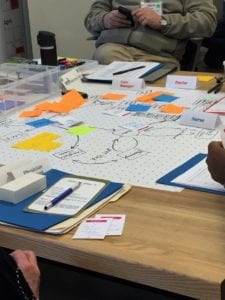Does Design Thinking Have a Place in Health Care? This Initiative Says Yes.
How do we improve the health care process? In a laboratory? In an operating room? For a new CQI that’s working on improving the transition from hospital to home or hospital to subacute facility to home, the group began by gathering at the studio for the Stamps Master of Integrative Design (MDes) program at the University of Michigan.
The unlikely pairing of art and design with health care process started with the project director, Lakshmi Halasyamani, MD, who was familiar with the concept of design science. When developing the new CQI, called the Integrated Michigan Patient-centered Alliance on Care Transitions, or I-MPACT, Dr. Halasyamani met with the design students, who suggested that observing the hospital transition processes would help inform what was working and what needed attention. With this background, the MDes students observed the care transition processes in several hospitals.
“It was difficult, because the process is so fragmented. The interactions between care providers, patients and family members are all different, and intertwined like spaghetti,” she says. “In fact, the students felt it was a stretch to even call it a process most of the time.” she added.
The students had two key insights:
- We have poor methods to assess levels of patient comprehension.
- We don’t involve patients in developing their own post-hospital care plan.
Using that insight, the CQI leadership decided to bring the CQI participants together to launch the initiative with an interactive, day-long workshop designed to get providers out of their silos and collaborate to identify and solve problems. Several patients and caregivers also participated in the workshop, bringing their experience and perspective into the equation.
“There are people here who care for the same patients along a continuum of care, but have never met each other. This workshop, and the CQI long term, brings the hospital side and ambulatory care side together to design solutions that improve the patient experience,” says Dr. Halasyamani.
Early in the day, the participants sat around tables that were stocked with colorful paper, pens, and custom-made game pieces.
Participants then heard directly from several patients, who each talked about their experiences being discharged from the hospital, yet still needing care at home. Each patient felt unprepared. Each patient described their experience as chaotic. Each patient needed help to coordinate the post-hospital care they needed.
The groups then gathered at their tables to role-play as they mapped out the care process and discharge planning process. Each group discovered as they went through each step that there is great variation in the process, because patients are unique in their needs, resources and situations.
“There is no typical day,” says one participant. “How do we develop a process if we are always putting out fires?”
Using design thinking and game play, each group was able to define a problem statement. That problem statement became the starting point for the challenge they will work to solve. By the end of the day, after active discussions, idea sharing and lots of post-it notes, each group had identified several interventions for improving their identified problem statement.
The one challenge that each group identified: The need to help patients navigate through the complicated health care system.
“This is the first time we’ve held an interactive workshop as a kick-off to a Collaborative Quality Initiative. And it’s the first time we incorporated design thinking into the mix,” says Rozanne Darland, manager of Collaborative Quality Initiatives at Blue Cross Blue Shield of Michigan. “The results so far have been outstanding.”
Each group within the I-MPACT CQI is now moving forward to implement the initial interventions they developed in the workshop. Groups will monitor and review progress, and the CQI as a whole will meet several times a year to share insights and best practices.
Long term, the participants aim to improve the patient’s experience as they transition from hospital to home. They also aim to reduce the rate of readmission back to the hospital.
For more information on the I-MPACT CQI, contact [email protected]





